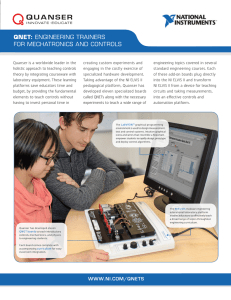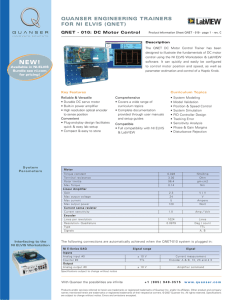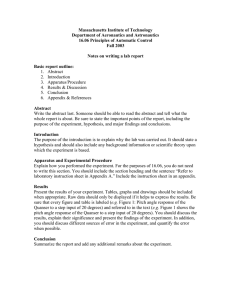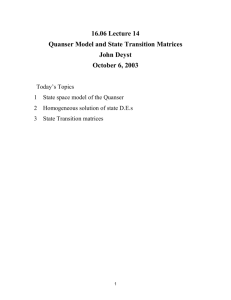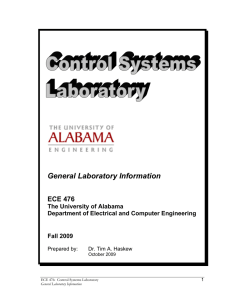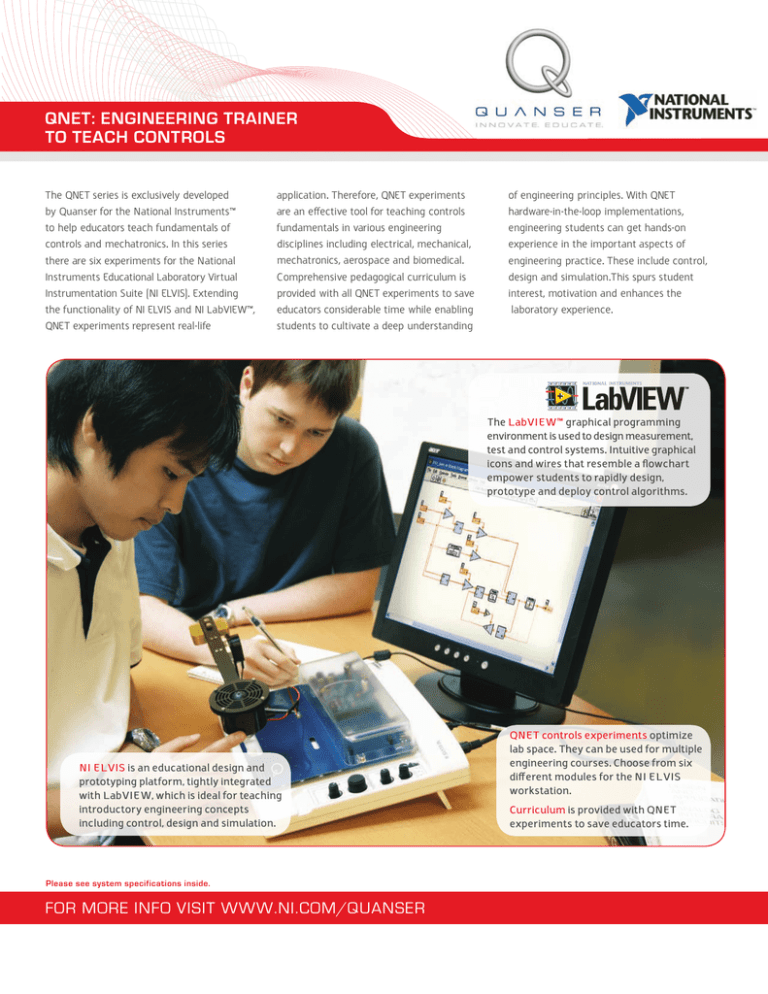
QNET: Engineering Trainer
to Teach Controls
The QNET series is exclusively developed
by Quanser for the National Instruments™
to help educators teach fundamentals of
controls and mechatronics. In this series
there are six experiments for the National
Instruments Educational Laboratory Virtual
Instrumentation Suite (NI ELVIS). Extending
the functionality of NI ELVIS and NI LabVIEW™,
QNET experiments represent real-life
application. Therefore, QNET experiments
are an effective tool for teaching controls
fundamentals in various engineering
disciplines including electrical, mechanical,
mechatronics, aerospace and biomedical.
Comprehensive pedagogical curriculum is
provided with all QNET experiments to save
educators considerable time while enabling
students to cultivate a deep understanding
of engineering principles. With QNET
hardware-in-the-loop implementations,
engineering students can get hands-on
experience in the important aspects of
engineering practice. These include control,
design and simulation.This spurs student
interest, motivation and enhances the
laboratory experience.
The LabVIEW™ graphical programming
environment is used to design measurement,
test and control systems. Intuitive graphical
icons and wires that resemble a flowchart
empower students to rapidly design,
prototype and deploy control algorithms.
NI ELVIS is an educational design and
prototyping platform, tightly integrated
with LabVIEW, which is ideal for teaching
introductory engineering concepts
including control, design and simulation.
Please see system specifications inside.
For more info visit www.NI.com/QUANSER
QNET controls experiments optimize
lab space. They can be used for multiple
engineering courses. Choose from six
different modules for the NI ELVIS
workstation.
Curriculum is provided with QNET
experiments to save educators time.
Applicable
Engineering
Discipline
Teaching Control with QNET and NI ELVIS: Six Experiments to Choose From
Choose from six QNET experiments to teach introductory controls to engineering students in electrical, mechanical, mechatronics, biomedical and
• Printers
• Cameras
• Robots
• CD players
• Vehicles
The Rotary Inverted Pendulum Trainer
offers students the opportunity to balance a
vertical rod at the tip of a rotating arm using
a DC motor. This is a classic pendulum control
experiment that can now be performed
more cost-effectively using the NI ELVIS
platform and LabVIEW™ software.
• Segway transporter
• Stabilization of rocket during take-off
• Human posturing system
• Traction control of vehicles
QNET HVAC Trainer
QNET Mechatronic
Sensors Trainer
QNET VTOL Trainer
Curriculum
Included
Technical Specifications
• Durable DC servo motor
• Built-in power amplifier
• High resolution optical encoder to sense position
• Plug-and-play design facilitates quick and easy
lab setup
• Compact and easy to store
• Protective cover to shield the circuitry
• System modeling
• Model validation
• Position and speed control
• System simulation
• Proportional–Integral–Derivative
(PID) Control design
• Tracking error
• Disturbance rejection
Motor
Torque constant
Terminal resistance Rotor inertia Max torque PWM Amplifier
Gain Max output voltage • Documented energy based-swing up control design
based on the pendulum link model
• Durable DC servo motor
• Precise and stiff machined components
• Built-in power amplifier
• High resolution optical encoders to sense positions
• Fully document system model and parameters
• Plug-and-play design facilitates quick and easy lab setup
• Compact and easy to store
• Protective cover to shield the circuitry
• System modeling
• Parameter estimation
• Balance control
• Linear-Quadratic Regulator (LQR) design
• Non-minimum phase
• Friction compensation
• Nonlinear swing-up control
• Energy-based design
• Hybrid balance / swing-up control
Motor
Torque constant
Terminal resistance Rotor inertia Max torque PWM Amplifier
Gain Max output voltage Max current Max output power Current Sensor
Sensitivity • Temperature control
• Relay / on-off control design
• System modeling
• Parameter identification
• roportional–Integral (PI) control design
Temperature Sensor
Calibration
Blower
Airflow
Chamber
Cross section area
Potentiometer
Mechanical angle range Independent linearity Infrared Sensor
Distance measuring range Pressure Sensor
Pressure range Sensitivity Quantization step Sonar
Object detection Sonar range 0.033 N.m/A
8.7 ohms
18 g.cm2
0.1 N.m
2.3 V/V
24 V
0.033 N.m/A
8.7 ohms
18 g.cm2
0.1 N.m
2.3 V/V
24 V
5A
120 W
1.0 A/V
The HVAC Trainer teaches students how
to design a control system that regulates
temperature in a chamber using the NI ELVIS
workstation and LabVIEW™ interface. It is
ideal for illustrating concepts covered in fluid
dynamics and thermodynamics control courses.
• Heating ventilation and air
conditioning system (e.g room
climate control)
• Incubators
• Aquarium
• Surge tank
• Bioreactors
• Transparent chamber
• Durable fan
• 12V halogen lamp as the heat source
• Integrated electronic temperature sensor
• Built-in power amplifier
• Plug-and-play design facilitates quick and easy lab setup
• Compact and easy to store
• Protective cover to shield the circuitry
The Mechatronic Sensors Trainer teaches
how to use various types of sensors and
demonstrates their advantages and
limitations. One of the most useful topics
in an introductory Mechatronics course
is the understanding and application of
sensors. This experiment introduces the
student to a wide variety of sensors that
are commonly used today.
• Magnetic field transducer for
throttle, pedal, suspension, and valve
position sensing
• Optical sensor for non-contact
position sensing and safety in an
assembly line
• Piezo film sensors to log vibration history
of package
• Various switches and LEDs are used in
electronic devices
• Sonar and infrared range sensors
often found in robots
Includes more than 10 different types of sensors/switches:
• Strain gage
• Piezo film sensor
• Rotary potentiometer
• Pressure sensor
• Thermistor sensor
• Sonar, infrared, optical, and magnetic field range
sensors
• Micro switch, push button, and optical switch
• Two digital output LEDs
• Encoder
• Plug-and-play design facilitates quick and easy lab setup
• Compact and easy to store
• Protective cover to shield the circuitry
• Benefits and drawbacks of certain
sensors
• Sensor behavior
• Calibration
• Using sensors to identify natural
frequency of material
• Need for debounce in switches
and buttons
• Understanding how encoders work
The Vertical Take-Off and Landing (VTOL)
module introduces students to the
fundamentals of aerospace engineering,
such as basic flight dynamics and control.
• Helicopters
• Rockets
• Balloons
• Harrier jets
• Tiltrotors
• High quality rugged propeller assembly
• Variable-speed fan with safety guard
• High resolution encoder
• Fully document system model and parameters
• Reliable QNET base and amplifier components
• Plug-and-play design facilitates quick and easy
lab setup
• Compact and easy to store
• Protective cover to shield the circuitry
• Flight dynamics, (e.g. modeling the
plant)
• Identifying parameters experimentally
• Model validation
• Proportional–Integral–Derivative (PID)
control
• Cascade control
• Dealing with actuator dynamics
Rotor
Power (at 1.5 A) Thrust (at 1.5 A) Efficiency (at 1.5 A) Encoder
Lines per revolution Resolution-quadrature Type Dimensions
Body length • Electromyograph with opto-isolated electrode and a
grounding strap
• Electromyograph runs on two AA batteries
• Pulse-width controlled metal gear servo
• QNET board includes signal conditioning circuit
and PWM
• Plug-and-play design facilitates quick and easy
lab setup
• Compact and easy to store
• Protective cover to shield the circuitry
• Analyzing the electromyogram signal
• Signal conditioning (e.g. ast Fourier
Transform (FFT) and filtering)
• Developing task-based servo
control from processed
electromyogram
EMG Sensor
Analog output Gain
Upper cut-off frequency
Lower cut-off frequency
Common mode rejection
ratio
Servo
Operating range Stall torque Dimensions Weight The Myoelectric trainer is an exciting way
to introduce students to biomedical
engineering. Students can learn how to
control a servo from the contraction of
muscles using the principles of
electromyography (EMG).
QNET MYOELECTRIC
Trainer
Key Attributes
• Myoelectric prosthetics
• Bioinstrumentation
• Clinical diagnostic tool: identifying
neuromuscular diseases
• Assisted control in aircrafts
• Unvoiced speech recognition
20 deg C/V
0.81 m3/min
15.9 cm2
300 deg
+/- 5 %
20 to 150 cm
0 - 207 kPa
0.0193 V/kPa
3 mV
Products and/or services pictured and referred to herein and their accompanying specifications may be subject to change without notice. Products and/or services
mentioned herein are trademarks or registered trademarks of Quanser Inc. and/or its affiliates. Other product and company names mentioned herein are trademarks or
registered trademarks of their respective owners. ©2010 Quanser Inc. All rights reserved.
Rev 2.0
Motor Encoder
Lines per revolution Resolution-quadrature Type Pendulum Encoder
Lines per revolution
Resolution- Quadrature
Type
Pendulum
Pendulum length Pendulum mass Coupling arm length 5A
120 W
1.0 A/V
360 lines
0.25 deg/count
TTL
360 lines
0.25 deg/count
TTL
1024 Lines
0.0879 deg/count
TTL
19.1 cm
27 g
8.26 cm
Pulse Width Modulation PWM Amplifier
Gain
2.3 V/V
Max output voltage
24 V
Max current
5A
Max output power
120 W
Current Sensor
Sensitivity
1.0 A/V
Resolution Reading frequency Piezo Film
Location of mass
from edge Sensitivity at resonance Resonant frequency
3dB frequency 2.54 cm
20 Hz
Fan chamber diameter Fan chamber height Counterweight mass Pitch range of motion
(from horizontal) PWM Amplifier
Gain Max output voltage Max current Max output power 6.8 cm
4.1 cm
270 g
1.40 cm
16.0 V/g
40.0 Hz
20.0 Hz
0 - 6.45 m
0.15 - 6.45 m
5.4 W
32 g
5.93 g/W
1024 lines
0.0879 deg/count
TTL
28.4 cm
+/-5 V
300 V/V
500 Hz
25 Hz
80 dB
4.8-6.0 V
0.294 N.m
2.9x1.3x3.0 cm
21.9 g
All QNET modules comply with the following international quality standards:
For more info visit www.NI.com/QUANSER
Max current Max output power Current Sensor
Sensitivity Encoder
Lines per revolution Resolution-quadrature
Type Isolation Amplifier
Input voltage
(accurate and linear)
Gain
Output low voltage
Output high voltage
Bandwidth
+/- 28 deg
2.3 V/V
24.0 V
5A
120 W
+/- 0.2 V
8 V/V
1.29 V
3.8 V
100 kHz
AEROSPACE
QNET DC Motor
CONTROL Trainer
The DC Motor Control Trainer illustrates
the fundamentals of DC motor control
using the NI ELVIS platform and LabVIEW™
software. It can quickly and easily be
configured to control motor position and
speed, as well as modeling experiments.
QNET Rotary
Inverted
Pendulum
Trainer
Real-life
Applications
BIOMEDICAL
Teaching Fundamentals
of Control
Mechanical
QNET MODULES
for NI ELVIS
To request a demonstration or quotation, please visit www.ni.com/quanser
ELECTRICAL
you will find a summary of key attributes, curriculum and technical specifications of each QNET module. Please note NI ELVIS is sold separately.
MECHATRONICS
aerospace. The table below provides an overview of how each QNET module can be used to demonstrate specific industrial applications. In addition,
BRING ADVANCED MECHATRONICS TO YOUR LAB
WITH LABVIEW™ AND QUANSER TECHNOLOGY
While the QNET series for the NI ELVIS provides a cost-effective solution
for teaching introductory control and mechatronics principals, you
can leverage the National Instruments™ educational platform for
advanced teaching and research. LabVIEW™ software and a wide
range of National Instruments™ hardware are fully compatible with
Quanser control experiments for intermediate and advanced level
teaching and research. The experiments cover topics applicable
to most engineering disciplines such as electrical, mechanical,
mechatronics, aerospace and civil. From rotary to linear and to
more advanced, Quanser experiments are distinctively modular. This
enables labs to maximize their investment in National Instruments™
technology and cost-effectively employ the same power plant and
data acquisition card to perform experiments of varying complexity.
tests, and final implementation. By combining these tools with the
LabVIEW™ Control Design and Simulation Module, students can take
advantage of custom algorithm development, analysis and visualization.
You can also integrate LabVIEW™ Real-Time and LabVIEW FPGA
software with NI hardware to quickly design, prototype, and deploy
your system using one single platform. National Instruments
multifunction data acquisition devices combine analog input, analog
output, digital I/O, and counter/timers on a single device. With new,
innovative analog and digital designs, M Series and X Series set a
new standard for performance, I/O capability, safety, and value.
NI R Series field programmable gate array (FPGA)-enabled I/O devices
offer the best combination of value and performance by integrating
FPGA technology with analog and digital I/O on a single device that
is available in standard PC form factors.
As illustrated below, easy integration with National Instruments™
hardware provides many options for prototyping, hardware-in-the-loop
Please visit www.quanser.com for a detailed list of National
Instruments™ cards that are compatible with Quanser experiments.
NI LabVIEW Control Design
and Simulation Module
Quanser AMPAQ
Quanser Active
Suspension
Unit
NI R Series
Multifunction
RIO Device
Quanser Comprehensive Curriculum
The Active Suspension is an example of a Quanser experiment that is suitable
for intermediate/advanced level teaching. The combination of LabVIEW™
software, National Instruments™ R Series multi-function devices and
Quanser experiment represents a self-contained control workstation. The
capabilities of this powerful yet adaptable bundle are extended further by
curriculum, complete with Instructor and student workbooks. The LabVIEWbased curriculum is developed by engineers for engineers to effectively teach
and demonstrate the mechatronic design approach practiced in industry. This
includes modeling, controller design, simulation and implementation.
See the full range of mechatronic controls experiments for LabVIEW™ and National Instruments
hardware at www.quanser.com/nimcc
About Quanser:
With 20 years in control design, Quanser is the world leader in education and research for real-time control design and implementation. We specialize in outfitting
engineering control laboratories to help universities captivate the brightest minds, motivate them to success and produce graduates with industry-relevant skills.
Universities worldwide implement Quanser’s open architecture control solutions, industry-relevant curriculum and cutting-edge workstations to teach introductory,
intermediate or advanced controls to students in Electrical, Mechanical, Mechatronics, Robotics, Aerospace, Civil, and various other engineering disciplines.
Quanser educational solutions are fully compatible with:
For more info visit www.NI.com/QUANSER

